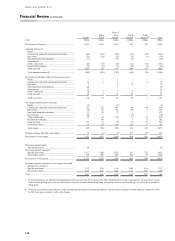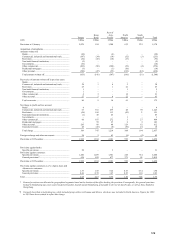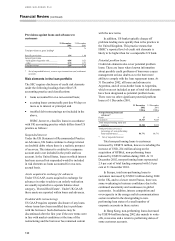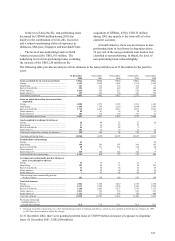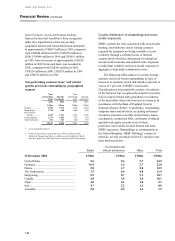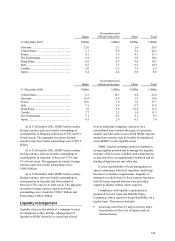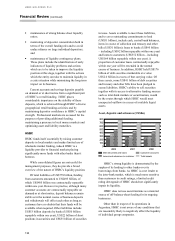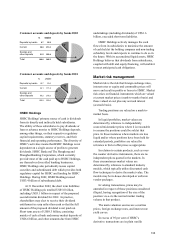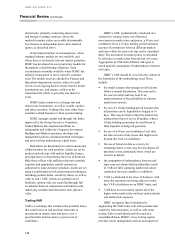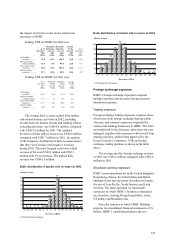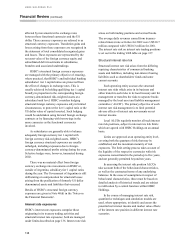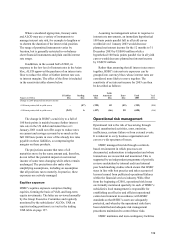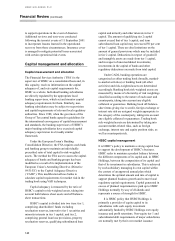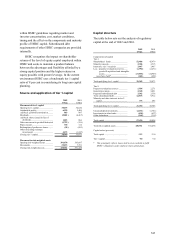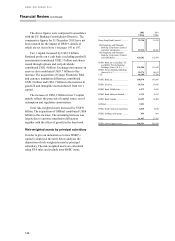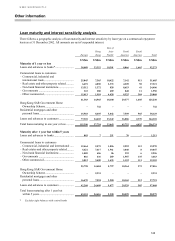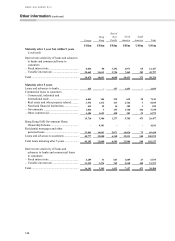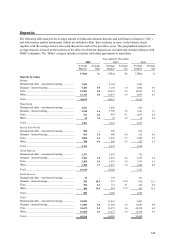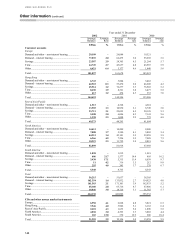HSBC 2002 Annual Report Download - page 138
Download and view the complete annual report
Please find page 138 of the 2002 HSBC annual report below. You can navigate through the pages in the report by either clicking on the pages listed below, or by using the keyword search tool below to find specific information within the annual report.
HSBC HOLDINGS PLC
Financial Review (continued)
136
instruments, primarily comprising interest rate
and foreign exchange contracts, where the
marked to market values are readily determinable
by reference to independent prices and valuation
quotes, as described above.
In the limited number of circumstances, where
standard industry models are not available, and
where there is no directly relevant market quotation,
HSBC has developed its own proprietary models for
the purposes of performing valuations. Such
circumstances normally would be where HSBC has
tailored a transaction to meet a specific customer
need. The models used are checked by Finance and
Operations departments and are subject to audit
review on an ongoing basis to ensure that the model
assumptions are, and remain, valid over the
transaction life which is generally less than five
years.
HSBC makes markets in exchange rate and
interest rate instruments, as well as in debt, equities
and other securities. Trading risks arise either from
customer-related business or from position taking.
HSBC manages market risk through risk limits
approved by the Group Executive Committee.
Traded Markets Development and Risk, an
independent unit within the Corporate Investment
Banking and Markets operation, develops risk
management policies and measurement techniques,
and reviews limit utilisation on a daily basis.
Risk limits are determined for each location and,
within location, for each portfolio. Limits are set by
product and risk type with market liquidity being a
principal factor in determining the level of limits set.
Only those offices with sufficient derivative product
expertise and appropriate control systems are
authorised to trade derivative products. Limits are set
using a combination of risk measurement techniques,
including position limits, sensitivity limits, as well as
value at risk (‘VAR’ ) limits at a portfolio level.
Similarly, options risks are controlled through full
revaluation limits in conjunction with limits on the
underlying variables that determine each option’s
value.
Trading VAR
VAR is a technique that estimates the potential losses
that could occur on risk positions taken due to
movements in market rates and prices over a
specified time horizon and to a given level of
confidence.
HSBC’s VAR, predominantly calculated on a
variance/co-variance basis, uses historical
movements in market rates and prices, a 99 per cent
confidence level, a 10-day holding period and takes
account of correlations between different markets
and rates within the same risk type and is calculated
daily. The movement in market prices is calculated
by reference to market data from the last two years.
Aggregation of VAR from different risk types is
based upon the assumption of independence between
risk types.
HSBC’s VAR should be viewed in the context of
the limitations of the methodology used. These
include:
• the model assumes that changes in risk factors
follow a normal distribution. This may not be
the case in reality and may lead to an
underestimation of the probability of extreme
market movements;
• the use of a 10-day holding period assumes that
all positions can be liquidated or hedged in 10
days. This may not fully reflect the market risk
arising from times of severe illiquidity, when a
10-day holding period may be insufficient to
fully liquidate or hedge all positions;
• the use of a 99 per cent confidence level does
not take account of any losses that might occur
beyond this level of confidence;
• the use of historical data as a proxy for
estimating future events may not encompass all
potential events, particularly those which are
extreme in nature;
• the assumption of independence between risk
types may not always hold and therefore result
in VAR not fully capturing market risk where
correlation between variables is exhibited;
• VAR is calculated at the close of business, with
intra-day exposures not being subject to intra-
day VAR calculations on an HSBC basis; and
• VAR does not necessarily capture all of the
higher order market risks and may underestimate
real market risk exposure.
HSBC recognises these limitations by
augmenting the VAR limits with other position and
sensitivity limit structures, as well as with stress
testing, both on individual portfolios and on a
consolidated basis. HSBC’s stress testing regime
provides senior management with an assessment of




